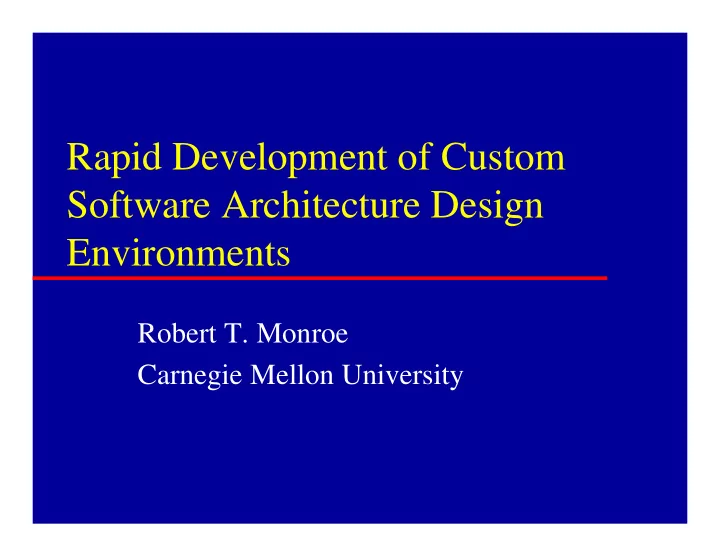

Rapid Development of Custom Software Architecture Design Environments Robert T. Monroe Carnegie Mellon University
Introduction and Motivation � Introduction and motivation � Capturing design expertise � Customizing design environments � Validation � Wrapup
Software Architecture � Software architecture design focuses on: – Decomposing a system into components – Interactions between those components – Emergent global system properties client System serverDetails Connection rpc Manager server Security database Manager
Premises � Software Architects can benefit from powerful design environments – CAD in other engineering disciplines – Design analysis, guidance, and reuse � The more closely a tool matches the problem it addresses, the more leverage that tool provides – Hammer ↔ Nail, Screwdriver ↔ Screw
Example Environment: C2
Example Environment: Meta-H
Example Environment: Aesop/PF
Example Environment: ObjecTime
Problems � Building custom design environments is: – Expensive – Time consuming – Difficult � Designers’ tooling needs change as their understanding of the problem, domain, and target system evolves
Solution: Armani � Support lightweight, incremental adaptation and customization of design environments – Factor out common infrastructure – Capture variable design expertise – Configure infrastructure with expertise expertise expertise expertise Generic Infrastructure Custom Environment
Unclogging Bottlenecks ���� �������������� ���� ��������������� ����� - ����������������������������������� - ���������������������������������� ��������������� ����� - ������������������������� ��� �������������������������������� ������������������� ����������������������� !�"#�������$ ���� - �������������������������� ���������$���������� - %��������������������������� �����$��������� ���������������������& ����������� - ��������������������������������� ���������������� ����� - ������������������������������ ����������� ������������������������������������
Thesis � Claim 1: – It is possible to capture software architecture design expertise with a language and mechanisms for expressing design vocabulary , design rules , and architectural styles . � Claim 2: – This captured design expertise can be used to rapidly and incrementally customize software architecture design environments.
Capturing Design Expertise � Introduction and motivation � Capturing design expertise � Customizing design environments � Validation � Wrapup
Architectural Design Expertise The concepts, models, and rules that skilled architects use when specifying, constructing, or analyzing a software architecture. Armani provides a declarative language for capturing architecture design expertise
Capturing Design Expertise � Design vocabulary – Building blocks for system designs – e.g. client , web-server , database , pipe , RPC � Design rules – Invariants, heuristics, and analyses – e.g. “ Transaction rate must be >= 1000 tph ” � Architectural styles – Package related vocabulary and design rules – e.g. Client-server, pipe-filter, batch sequential
Design Vocabulary Example Component Type naïve-client = { Port Request = { Property protocol = rpc-client }; Property request-rate : integer << default = 0; units = “rate-per-sec” >>; Invariant forall p in self.Ports | (p.protocol = rpc-client); Invariant size(Ports) <= 5; Invariant request-rate >= 0; Heuristic request-rate <= 100; }
Design Rule Example System simpleCS = { … // simple rule requiring a primary server Invariant exists c : server in self.components | c.isPrimaryServer == true; // simple performance heuristic Heuristic forall s : server in self.components | s.transactionRate >= 100; // do not allow client-client connections Analysis no-peer-connections(sys : System) : boolean= forall c1, c2 in sys.components | connected(c1, c2) -> !(declaresType(c1,clientT) and declaresType(c2, clientT)); … };
Architectural Style Example Style naïve-client-server-style = { // declare vocabulary Component Type naïve-client = {...}; Component Type naïve-server = {...}; ... // declare design analyses Analysis no-peer-connections(sys : System) : boolean = { ... }; ... // declare style-wide design rules Invariant no-peer-connections(self); Heuristic forall s : server in self.components| s.transactionRate >= 100; ... } // end style definition
Predicate-Based Expertise Capture � (Most) expertise represented w/predicates – Simple type checking tests constraints – Predicates can be written over structure, properties, topology � Clean, flexible approach to subtyping � Excellent compositionality and modularity � Predicates can apply to types or instances
Language Supports Approach � Language provides environment foundation – Good representations ease environment impl. – Reconfigures environment “on the fly” � Language provides flexible representation for – Types – Design rules – Design instances � Constraint checking forms tool foundation
Customizing Design Environments � Introduction and motivation � Capturing Architecture Design Expertise � Customizing Design Environments � Validation � Wrapup
Example Environment: Armani
Customizing Design Environments � Fundamental approach – Provide a fully-functional generic environment – Support fine- and coarse-grained customization � Key design goals – Incremental effort leads to incremental payoff – Standard, common customizations are quick, easy, and incremental. – More complex customizations are possible – Leverage design language as much as possible
Core Environment Infrastructure Generic elements: ������������� ��������������� – Design Rep w/API ������������� ��������������� ����� ������ – Parser & unparser ������ ������ Core Armani ��������������� API – Type checker ���������������������������������� – Analysis Engine ���� ���� !������� ������ ������ ������� ������� ���� ���� – GUI ������������ !�������������� ������ ����������� ����������� ����� Visio - System Workshop �������������� ����������� Java VM Visio-based GUI (external tool)
Generic Armani Environment � Capabilities: – Define arch. specifications – Brings some rigor to box-and-line drawings � Limitations – Limited semantics – Architect must build-up design concepts
Customization Techniques � Fine-grained – Add or modify envt’s stored design expertise – Customize graphical depictions within a GUI � Coarse-grained – Integrate external tools – Completely replace GUI
Fine-Grained Customization expertise expertise expertise (repeat) Generic Infrastructure Custom Environment Add To or Retrieve From Design Expertise Define or Repository Define or Modify Modify Visualizations Expertise
Coarse-Grained Customization � Coarse-Grained ≈ external tool integration � Some expertise is better captured with tools – When it does something to or with a design – When it is contained in legacy tools – When you have to specify how to evaluate it instead of just what to evaluate � More effort, (potentially) more power
Integrated Tool Examples � Multiple Armani user interfaces � Performance analysis tool (Lockheed study) � Change impact and configuration consistency analysis tools (MetaS study) � Security and fault-tolerance analysis tool (DesignExpert study) � Runtime architecture evolution checking (C2 study)
Recommend
More recommend